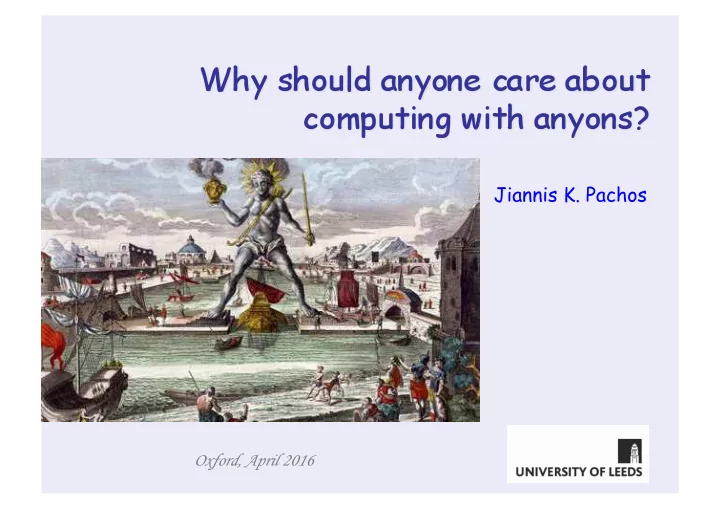

Jiannis K. Pachos Oxford, April 2016
Computers Antikythera mechanism Robotron Z 9001 Analogue computer Digital computer: 0 & 1
Computational complexity • Problems solved in: - poly time (easy) - exp time (hard) ...with input size. • Classical computers: P : polynomially fast to solve NP : polynomially fast to verify solution • Quantum computers: BQP : polynomially easy to solve with QC Factoring , searching , quantum simulations , …. Errors during QC are too catastrophic
Topological quantum computation Topology promises to solve the problem of errors in quantum computers … …and it is lots of fun :-)
Geometry – Topology • Geometry – Local properties of object • Topology – Global properties of object geom. topo.
Topology of knots Are two knots equivalent? topo. Algorithmically hard problem…(‘60s) • Common problem (speech recognition, …) • Jones polynomials recognise if two knots are • not equivalent. Solve:“ Λύνω ”: disentangle: Alexander and Phrygia •
Topological quantum effects Aharonov-Bohm effect Magnetic flux and charge The phase is a function of winding number Topological effect: is the integer number of rotations
Particle statistics Exchange two identical particles: Statistical symmetry: Local physics stays the same… …but could change!
Particle statistics Bosons 3D Fermions 2D Anyons Anyons: vortices with flux & charge (fractional) . Aharonov-Bohm effect � Berry Phase .
Anyons and physical systems Anyonic properties can be found in 2-dimensional topological physical systems: Fractional quantum Hall liquids • Topological insulators & SC • 2D Lattice systems • [FQHE, is purely 2D. Lattice models: QD, LW, KHoney, TI & TSC…]
Statistics and Berry phase :position of Excited state anyons (classical) Statistics Berry phase
Anyons and entanglement entropy Ground state Entropy Quantum dimension
Anyons and entanglement entropy :position of Excited state anyons (classical) Entropy Quantum dimension
Anyons and knots Initiate : Pair creation of anyons time Braiding Measure : do they fuse to the vacuum?
Anyons and knots
The Reidemeister moves Theorem : Two knots can be deformed continuously one into the other iff one knot can be transformed into the other by local moves :
Skein relations
Skein and Reidemeister Reidemeister move (II) is satisfied. Similarly (III).
Kauffman bracket The Skein relations give rise to the Kauffman bracket : Skein( )=
Jones polynomials The Skein relations give rise to the Kauffman bracket : Skein( )= To satisfy move (I) one needs to define Jones polynomial :
Jones polynomials If two links have different Jones polynomials • then they are not equivalent => use it to distinguish links Jones polynomials keep: • only topological information, no geometrical
Jones polynomial from anyons Braiding evolutions of anyonic states: Simulate the knot with braiding • anyons Translate it to circuit model: • <=> find trace of matrices
Jones polynomial from QC Evaluating Jones polynomials is a #P-hard problem. With quantum computers it is polynomially easy to approximate with additive error. Belongs to BQP class. [Freedman, Kitaev, Larsen, Wang (2002); Aharonov, Jones, Landau (2005); et al. Glaser (2009); Kuperberg (2009)]
Conclusions Fundamental properties of • anyons provide resilient QC. Encrypt quantum info • Quantum money • Quantum Anonymous • Broadcasting Anyonic systems are currently engineered ... www.theory.leeds.ac.uk/jiannis
Topological physics
Letter from Faraday to Whewell (1834)
Recommend
More recommend